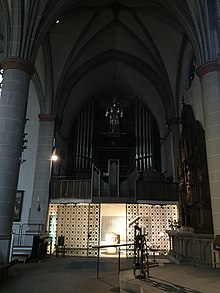Propsteikirche St. Peter and Paul (Bochum)
The catholic provost church St. Peter and Paul is the oldest and until 1655 only church in Bochum . It is counted among the twelve oldest churches in Westphalia .
history
Between 785 and 800, Emperor Charlemagne laid out an imperial court on the site . A wooden mission chapel dedicated to St. Peter was probably built on the hill next door .
This building was replaced by a stone hall church in the 11th century . This church fell victim to a fire on April 25, 1517. It was rebuilt in 1547 as a late Gothic hall church, re- using the old Romanesque choir .
Until the Protestant Pauluskirche was built between 1655 and 1659, the only church in Bochum was used by both denominations for around 100 years.
In 1766 the tower was restored and between 1872 and 1874 the church was expanded to include a transept , a five-sided polygonal choir and a sacristy.
In 1881, as a trigonometric point of the 2nd order , the church became the center of Soldner's coordinate system number 33 for the Prussian new entry . It was not until the 1920s that these individual coordinate systems were replaced by the Gauß-Krüger coordinate system in national surveys .
In 1920 there was another fire. The damage was repaired within the following two years. The construction took much longer in two phases (1947–49 and from 1954) after the Second World War , in which the church was largely destroyed. The side aisles were lengthened and two new chapels were added. The reconstruction was not completed until 1959.
From 1976 to 1977 the interior of the church was completely renovated. In cooperation with the state and diocesan conservator, the church was given a little more color, without being closely linked to the historical findings. The altar island was brought forward and the restoration of the altars continued.
Until the 1980s, the Bochum Propsteikirche was a place of eternal worship .
The 68 meter high defense tower with three window axes on the two upper floors is one of Bochum's landmarks. Before the damage in World War II, it was adorned with stone parapets and corner turrets. It houses five large cast steel bells that were cast in the Bochum Association . The strikes of the bells are g sharp 0 , h 0 , c sharp 1 , e 1 and f sharp 1 .
Furnishing
- The five-sided wing retable probably dates from around 1884. The linden wood reliefs show depictions from the life of Christ. The central panel is from more recent times.
- The wooden cross altar was made in 1884 by Theodor Brockhinke. The middle part shows a mercy seat , the head and upper body of a figure of Christ from the 13th / 14th centuries were made. Century used.
- The wooden Marian altar from 1884 is also a work by Brockhinke; the main picture with a rosary Madonna was painted by Franz Ittenbach in 1875 . The wooden core of the reliquary in the cafeteria , with the relics of St. Perpetua and Felicitas, was clad with silver and gilded copper sheeting around 1100. Around 1200 the long sides were adorned with enamelled arcatures in which there are late Gothic figures of the apostles embossed in silver. The shrine was redesigned in 1881.
- The tabernacle of stone was created around the 1460th
- The Romanesque font from around 1175 is decorated with awkward relief depictions from the life of Christ and a palmette frieze.
- The wooden crucifix, the so-called Bladenhorster Cross, was carved by Bernhard von Waltrop in 1352, the cross is from more recent times.
- The oak lamentation group dates from around 1520.
- The tabernacle created by Fritz Schwerdt dates from 1959 and replaced a simple safe that had been in use up until then.
organ
The organ was built between 1958 and 1959 by the organ builder Franz Breil (Dorsten). In 1974 the breastwork was converted into a swellwork and the organ was expanded. The slider chests -instrument has 44 registers on four manuals and pedal . The playing and stop actions are electric.
|
|
|
|
|
||||||||||||||||||||||||||||||||||||||||||||||||||||||||||||||||||||||||||||||||||||||||||||||||||||||||||||
- Coupling : II / I, III / I, III / II, IV / I, I / P, II / P, III / P, IV / P
See also
Web links
literature
- Dehio, Georg , under the scientific direction of Ursula Quednau: Handbook of German art monuments. North Rhine-Westphalia II Westphalia . Deutscher Kunstverlag , Berlin / Munich 2011, ISBN 978-3-422-03114-2
Individual evidence
- ↑ Duisburg intelligence slip no. XXXIV
- ↑ An overview of the Soldner systems can be found in the dissertation by Rudolf Schmidt (Die Triangulations in Nordrhein-Westfalen, Bad Godesberg 1960) in Fig. 58.
- ↑ Episcopal General Vicariate Essen, Dept. Information / Episcopal Press Office (ed.): Our common path. 25 years of the Diocese of Essen . Edition Werry, Mülheim an der Ruhr 1982. ISBN 3-88867-019-5 . P. 66.
- ↑ More information about the organ (PDF; 8.4 MB) p. 255.
Coordinates: 51 ° 28 ′ 56 ″ N , 7 ° 13 ′ 14 ″ E




